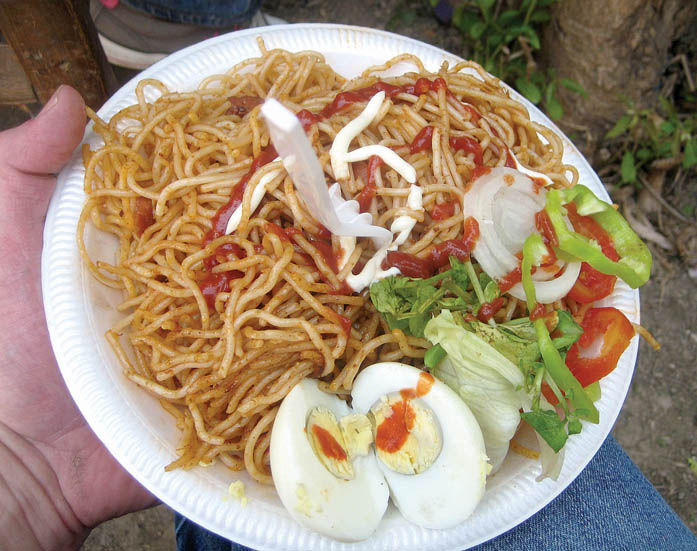Funny Friday Haitian Jonas Gold Everything Parody (Sauce Pwa Everything)
Pop the picklies i'm sweatin'
Pre-Kanival Activities Haiti
Friday, Dithny Joan Raton, the new Minister of Culture, accompanied by amon others accompanied particularly Stéphanie Balmir Villedrouin, the Minister of Tourism and Creative Industries (MTIC), François François Jr., Minister of Communication and Gregory Saba, Preisdent of the Carnival Committee, officially launched the National Carnival, which will return this year in Port-au-Prince, 15, 16 and 17 February, after having been relocated previous years in Les Cayes, Cap-Haïtien and Gonaïves http://www.haitilibre.com/en/news-12969-haiti-social-the-national-carnival-returns-to-port-au-prince.html
The Minister of Culture also Honorary President of the Carnival 2015 promises that the artistic performances will be at the rendezvous again this year. "The 11 departments of the country will be represented by allegorical floats on the course of the carnival. The West department will be represented by the Iron Market, Southeast will be represented through art and the Carnival of Jacmel..."
Stéphanie Balmir Villedouin, indicated that for this major cultural event, hotels have launched special packages for visitors. In addition, discussions are underway with airline officials to provide benefits to foreign visitors, for its part informed Gregory Saba.
Twelve to thirteen musical groups will be selected for the three fat days in accordance with the criteria defined by the Organizing Committee. The budget of the National Carnival 2015, to be held under the theme "Nou Tout Se Ayiti", is not yet known, but the Government should fund the event at 20% and 80% by the private sector said Mr. Saba.
Pre-carnival activities :
Until that great time of rejoicing the Pre-carnival activities began Sunday, January 18 and will continue every Sunday until 8 February 2015 on the theme "Bay Ayiti yon Chans" www.haitilibre.com/en/news-12969-haiti-social-the-national-carnival-returns-to-port-au-prince.html 44 walking bands and at least 8 DJ tanks will ensure the animation at Champ de Mars from 4:00 pm to 11:00 pm. Already more than twenty carnival meringues are broadcast on the internet and in the media in Haiti http://www.haitilibre.com/en/news-12978-haiti-carnival-2015-follow-jah-innovates-by-launching-simultaneously-two-carnival-songs.html
Heavy toll :
Sunday, January 25, despite the mobilization and deployment of 1,500 police officers during this second Sunday of festivities, the provisional toll was heavy with 2 shot dead and 16 injured, according to the Commissioner Garry Desrosiers, Deputy Spokespersons of the National Police of Haiti. A result well above the 6 wounded with edged weapons, recorded on January 18 http://www.haitilibre.com/en/news-12989-haiti-news-some-news-here-and-there.html , first Sunday of the pre-carnival activities.
(Source) http://www.haitilibre.com/en/news-13042-haiti-culture-pre-carnival-activities-heavy-toll.html
Zoe Pound / Redd Eyezz On Gangland
Nan Lakou Kanaval Trailer
A journey through the Haitian carnival as experienced by a young woman, this film straddles the lines between documentary, visual poem, and hallucination. Filmed in hyper-saturated 16mm, angels of death and groups of men covered in black syrup battle a giant "Master of Midnight" with fire blazing in his eyes to the beat of Haitian rara and raboday music. Created in collaboration with the director's students from the Cine Institute in Jacmel, Haiti, and based on a poem by young Haitian poet Gabriel Wood Jerry.
Breakfast Spaghetti with Hot Dog- The Haitian Way
If you ask any of the people really close to me in my life they will tell you that this is my favorite guilty pleasure. I love Haitian breakfast spaghetti with hot dogs. The only thing this video is missing is some ketchup and mayonnaise and a few banan peze and some fresh picklies on the side. I know americans always say "ewe that is so gross", but for real don't knock it until you try it.
Haitian Spaghetti with Hot Dogs
Ingredients
- 1lb Spaghetti
- 3 tablespoons Olive Oil
- 3 tablespoons Tomato Paste
- 1 tablespoon Garlic (chopped)
- 1 cup White Onion (sliced)
- 1 teaspoon Thyme (fresh, leaves only, can use dried)
- 5 hot dogs
- 1 1/2 tablespoon Chicken Bouillon Powder or 1 Cube
- Salt to taste
- 1 1/2 cups Reserved Pasta Water
- Ground Black Pepper (to taste)
- 1 Habanero
- Crushed Red Pepper (to taste-optional)
- Ketchup (preferably a caribbean sweet version)
- Mayonnaise
Directions
Boil pasta according to package. Reserve 1 1/2 cups of the pasta water for later use.
In a heavy large saucepan, heat oil and add tomato sauce or ketchup. (if using ketchup add 1 additional tablespoon) Cook tomato paste for 3 - 4 minutes while stirring occasionally. Add garlic, onion, whole haanero, thyme, and hot dog and cook for 4 minutes while stirring to blend. Add chicken bouillon and stir. Add pasta and stir to blend while gradually adding the pasta water. Lower heat and cover and cook for another 4-5 minutes. Add crushed red pepper if using. Season with salt and pepper to taste. Let the noodles crisp up just a bit for little bits of crunch to taste. Top with ketchup and mayonnaise and serve with banan peze and picklies, or some hard boiled eggs and avocado.





Haitian Hip-Hop Healing Haiti | UNICEF
Interesting and surprising project for UNICEF.
Genius Bill Strickland on the Importance of Art and Entrepreneurship
MTB Ayiti International Stage Race
The MTB Ayiti Stage Race combines a once-in-a-lifetime cultural immersion experience with the opportunity to build the foundation for a sustainable adventure tourism industry while racing a challenging course thru some of the most rugged and awe-inspiring terrain in the Western Hemisphere.
The 2nd Annual Haiti International Mountain Bike Race is Jan 28 - Feb 2rd, 2014. Register at mtbayiti.org/register
La Bonne Nouvelle Cotes de Fer
The Beauty of Haiti
A highlight reel of my favorite footage from my time in Haiti, some of which was used in "Missions in Haiti." from ReelCast Productions
Filmed with the Canon C100 using C-LOG
- Canon 70-200 L f/2.8 IS
- Canon 17-55 f/2.8 IS
Also used Kessler Philip Bloom Slider
Edited and color graded in Adobe Premiere
naive painting
I am not really sure what this is, but I like it.
Fabulous Flags
Haitian artisan Jean Baptiste Jean Joseph, one of the finest beaders working in Haiti today, provides viewers a tour of his workshop and explains the tradition of Haiti’s voudou flags -- beaded textiles that illustrate Haiti's vivid spiritual tradition, vodou, with its vivid, syncretic combination of Roman Catholic saints, West African deities, and uniquely Haitian figures.
Dithny Joan Raton takes control of the Ministry of Culture
The very dynamic Director South East of the Ministry of Tourism and Creative Industry (MTIC) Dithny Joan Raton, promoted Minister of Culture (MC) in the new consensus Government Martelly-Paul, took office Tuesday.
The ceremony took place in the presence of Anne Valérie Timothée Milford, Director of the private cabinet of the President Martelly, Stéphanie Balmir Villedrouin, the Minister of Tourism, Stefan Malebranche, Director Génral and of Autonomous Bodies Directors General of the Ministry of Culture.
Monique Rocourt, outgoing Minister expressed her satisfaction for the past nine months at the head of the Minsitry and thanked the employees for their support and frank cooperation. Mrs. Rocourt said she was convinced that the executives of the Ministry will continue the same collaboration with the new Minister.
From the outset, Dithny Joan Raton, said she is aware of the magnitude of the task to accomplish as a holder of this Ministry. Welcoming the achievements of her predecessors, she expressed her determination to continue in their wake, especially in the domain of the restoration of the built heritage "The challenges are of sizes, the legacy is heavy," admitted Mrs. Raton, which remains convinced, however, that it is at the cost of hard work, she will manage to meet, over time, this great challenge.
(source) http://www.haitilibre.com/en/news-12995-haiti-culture-dithny-joan-raton-takes-control-of-the-ministry-of-culture.html
Haiti Friends' HTRIP Program and the Moringa Oleifera Tree
HTRIP - Haiti Timber Re-Introduction Program
Happy new year to you all, readers, and HTRIP contributors,
As the beginning of the new year makes way for a fresh start and new opportunities, I am very delighted to announce my most recent initiative as HTRIP's Program Manager: the publication of monthly e-blasts about the different tree species that are traditionally grown in Haiti as well as cultivated by farmers in the Artibonite with the help of the Haiti Timber Reintroduction Project.
The Haiti Timber Reintroduction Project, in partnership with Hospital Albert Schweitzer in the Artibonite Valley since 2006, has begun an educational Agroforestry and tree planting program to help mountainous farmers restore tree cover on highly eroded lands in the Artibonite. HTRIP has been encouraging the planting of various tree species that are used for multiple purposes, including fodder, fuel wood, and nitrogen fixation. For instance, Moringa is a tree that is widely appreciated in Haiti for its countless ecological and nutritional advantages of being able to fight malnutrition to fixing nitrogen into the soil.
Moringa Oleifera, usually referred to as the Miracle Tree or The Tree of Life, is native to India and well-known in Latin America and Africa for all its nutritional value and effectiveness in curing malnutrition. Almost all parts of the moringa tree are edible, but people in Haiti mostly eat the leaves and make cooking oil with the seeds. Besides its nutritional benefits, moringacan also help environmentally-vulnerable countries like Haiti to fight erosion and deforestation – Haiti’s biggest ecological problems. It can be propagated via seeds or cuttings and is also able to develop easily and rapidly in very poor soil conditions.
In order to help address deforestation in Haiti, HTRIP continues with assisting mountainous farmers in their sustainable tree planting efforts, and this year HTRIP is directly touching the lives of more than 1,300 farmers in the Artibonite with its monthly trainings on different environmental topics such as composting, soil conservation, and seedling production. It also aims to plant more than 400,000 trees including 20,000 moringa trees during the coming summer.
Peace and Trees,
Melissa Sanon
HTRIP program Manager
Thanks to supporters like you, the HTRIP staff and farmers will plant the two millionth tree in Haiti this summer. Below is a breakdown of the 400,000 trees lined up for this year's planting season.
Planting trees in Haiti means SURVIVAL and an INCREASED QUALITY OF LIFE.
Each tree has a life-changing economic impact on individuals and families. To continue HTRIP's triumphs, we need your support! Donations are critical to our success of reforesting Haiti.
Jerry: A Portrait of a Graffiti Artist (Democracy in Haiti series, #1)
English:
To commemorate the 4th anniversary of the Haitian earthquake, Nomadic Wax is releasing a new short on the Port-au-Prince-based graffiti artist, Jerry Moise Rosembert, as part of their Democracy in Haiti series.
Jerry, 29, is Haiti's most prolific graffiti artist. In the video short, he discusses his transition to more socially conscious work after the earthquake and his vision to bring about change through his art.
In the months after January 12th, 2010, Jerry festooned the walls of Port-au-Prince with critiques of foreign aid and murals to raise awareness of cholera. Slogans like "I love Haiti" and "Haiti will not perish" appeared on the walls mysteriously during the night. Jerry's positive portrayals of Haitians and of Haiti's future quickly became an inherent and much-loved part of the city, and Jerry has become a local hero.
For more information on the series, please visit democracyinhaiti.com/. If you would like to view some of the other shorts released as part of the series: vimeo.com/channels/253670. And if you haven't already, download the mixtape: nomadicwax.bandcamp.com/track/democracy-in-haiti-mixtape





Children of a Motherless Land
This is an introduction to Haiti and the children that have no one else to stand up for them. Our goal is to raise awareness and lead all underappreciated children toward a brighter existence. Help us invest in our children; they are our future.
NBC - What Does Haiti Have to Show for $13 Billion in Earthquake Aid?
BY TRACY CONNOR, HANNAH RAPPLEYE AND ERIKA ANGULO
Americans texted tens of millions of dollars in donations and governments gave billions, but five years after an earthquake left corpses and rubble piled across Haiti, 85,000 people still live in crude displacement camps and many more in deplorable conditions.
The disconnect between the massive amount of private and public aid and the poverty, disease and homelessness that still plague the country raises a question that critics say is too difficult to answer: Where did all that money go?
In Coralia this week, father of two Serafin Jean Rose, 33, said he has benefited from the American dollars that have poured in since Jan. 11, 2010.
After his home was destroyed, he was moved to one of the tent camps. A year ago, they were given enough money to move out and build a tin house. He works as a carpenter and has been able to feed his family of four.
"I'm one of the lucky ones," he told NBC News.
Jean-Louis Wilner stands on the rubble of his demolished neighborhood in central Port-au-Prince, Haiti, July 7, 2014
Ninety-five percent of the 1.5 million people who were in camps in 2010 have been moved, but many of them are still not in permanent housing. At least 200,000 people are in new hillside slums, known as Canaan-Jerusalem, where there are wooden and tin homes but no running water, electricity or sanitation yet.
A high-profile celebrity-backed charity is being probed for its use of funds, and some U.S.-backed projects have been scaled back or scrapped.
"You have donors disburse money, but that doesn't mean all that money is spent on the ground," said Jake Johnston of the Center for Economic and Policy Research.
"If the expectation was to build back better and transform Haiti's public sector, then yes, by any measure it's been a failure," Johnston told NBC News. "But that isn't to say there have not been successes."
In the immediate aftermath of the 7.0-magnitude quake, heart-rending images beamed in from the island to U.S. homes spurred Americans to open their wallets for victims in the poorest country in the Western hemisphere.
They gave $1.4 billion to relief and recovery efforts over the course of the next year, according to an analysis by the Chronicle of Philanthropy. Of that, $32 million alone came in the form of $10 text messages to the American Red Cross.
At a donors conference in New York three months after Port-au-Prince and much of the south was wrecked, nations from around the globe, led by the United States, pledged billions more for the short and long term — to be managed by a commission co-chaired by Bill Clinton and the Haitian prime minister.
The United Nations said that in total $13.34 billion has been earmarked for the crisis through 2020, though two years after the quake, less than half of that amount had actually been released, according to U.N. documents. The U.S. government has allocated $4 billion; $3 billion has already been spent, and the rest is dedicated to longer-term projects.
Some global development analysts say that the spending structure — with the vast majority of money being funneled through foreign contractors instead of the Haitian government or local outfits — has built-in inefficiencies, compounded by a lack of accountability and transparency.
The U.S. Agency for International Development, which oversees the aid program, says using experienced Beltway-based firms that could move quickly in the beginning was a necessity, but acknowledges that more should go to local entities. The new goal is to put 17 percent of funding in Haitian hands.
The American companies relied on a maze of subcontractors, increasing overhead and obscuring whether the money was being spent wisely, critics said.
"It was really hard getting our hands around this," said Rep. Barbara Lee, D-Calif., who authored a bill signed into law last month that requires more robust reporting of how aid is being spent going forward.
Still, there is no doubt many lives were saved and good work was done, under daunting circumstances and in the face of overwhelming destruction.
"Our successes far outstrip our failures," said Beth Hogan, an administrator for USAID. Tom Adams, the State Department's special coordinator for Haiti, conceded "it has been a challenge to implement certain parts of our assistance package," but pointed to progress in job creation, health, security and agriculture.
A man walks past a camp for people displaced by the earthquake on March 4, 2012 in Port-au-Prince.
The USAID list of expenditures includes: emergency food for 4 million, temporary shelter for 1.5 million, 2.7 million cubic meters of rubble removed, 600 classrooms created, construction of a power plant for a new U.S.-brokered factory park, support for 160 health clinics, funding to arrest a cholera outbreak that killed nearly 9,000, better technology for farmers, and the creation of permanent housing.
The housing program can hardly be branded a success, though. A government audit in 2013 found that USAID underestimated how much would be needed for settlements, ballooned the budget from $59 million to $97 million while cutting its goal from 15,000 houses to 2,649. It's put up about 900 so far.
"We realized we are not going to come anywhere close to building the kind of housing stock Haiti requires," said Hogan, saying the focus has shifted to financing so Haitians can build or improve homes themselves.
In the meantime, there are still 85,000 people in displacement camps — half of which did not have latrines, according to a 2014 UN report. Development plans for Port-au-Prince meant some downtown renters were evicted, their buildings demolished, earlier this year.
"I'm worse off than after the earthquake," said Jean-Louis Wilner, 32, who spent two years in a tent camp before scoring a rental apartment in the capital that was recently taken down to make way for a government center.
"It's humiliating," he told The Associated Press.
USAID also scrapped plans to build a new port in northeastern Haiti after delays mounted, projected costs skyrocketed, and it became apparent shippers would not use it — and, as the Miami Herald reported, after it spent $4.5 million on feasibility studies.
Audits of other contracts have also highlighted problems with small projects. A North Carolina company that was paid $12.9 million to develop a Creole-based school curriculum got poor grades from US AID's inspector general, who noted that some team members didn't even speak French.
Haiti hip-hop star Wyclef Jean greets the crowd before officially registering as a presidential candidate at an office in the Delmas neighborhood of Port-au-Prince in 2010.
The private sector — which accounts for $3 billion to the aid bottom line — has seen its own share of funding successes and pitfalls.
The American Red Cross released a breakdown of spending and plans for $488 million in donations collected in the last five years — from solar-powered street lights and mountains of mosquito nets to 5,300 units of blood and $10 million to reconstruct St. Michel Hospital. A $22 million, 300-bed teaching hospital in Mirebalais, built and run by Partners in Health, is often cited as a bright spot.
Then there's the troubling case of Fugees rapper Wyclef Jean's Yele Haiti charity, which took in $16 million in 2010 on the strength of his star-power, and spent more than $4 million on internal expenses like salaries, consultants, travel and office and warehouse expenses. Sean Penn's J/P Haitian Relief Organization spent just 10 percent of its revenue on those kind of overhead costs.
Yele dissolved in 2012 amid questions about its bookkeeping and payouts, and the New York attorney general's office said this week it is still investigating the group's finances. On a smaller scale, North Carolina authorities yanked the license of a charity called Share Our Shoes after finding more than $50,000 in questionable expenses.
To Jonathan Katz, author of "The Big Truck That Went By: How the World Came to Save Haiti and Left Behind a Disaster," the aid story is one of good intentions and bad policy, short-term fixes without a ground-breaking long game, Band-Aids over self-sufficiency.
"If you gave $10 to the American Red Cross, eventually, 90 percent of that money would have gotten spent on something — part of a tarp to go over a family's head, part of a bag of rice to feed a couple of people, salary or transportation for American aid worker. That money would have been spent very, very quickly," Katz said.
"But there's no practical connection between putting a tarp over someone's head on Day 3 or 7 and putting a roof over someone's head five years later."
Photo contest open to all
The Ministry of Tourism and Creative Industries (MICT), organizes again this year, a photo contest on the pre-carnival activities as well as the Carnival of Jacmel and the National Carnival 2015, to be held in Port-au-Prince. MTIC invites all amateurs and professionals to compete.
Regulation of amateur contest :
Are accepted all pictures taken on the fly during the pre-Carnival activities, with a photography equipment even rudimentary (phone, tablet...) must be sent to participate in the contest from Monday, January 26. The pre-selected photos, will be posted on the social networks Facebook and Instagram of the Ministry. The 3 photos having received the most "like" on the two social networks combined, will be selected for the grand finale "Amateur of Amateurs" during the presentation of the premiums of plezikanaval.com
Participants must send its photo (s) by email to: direction.communication@tourisme.gouv.ht and to concoursphotos.tourisme@post.com
Regulation of professional competition :
All photos taken (maximum 4) by a professional photographer during the Carnival of Jacmel 6, 7 and 8 February 2015, or during the three fat days of the National Carnival 2015 or the 15,16 and 17 February, should be sent by email to : direction.communication@tourisme.gouv.ht
The photographs received will be evaluated by a jury, which will elect the winner of this category.
12 talented young artists to discover
The exhibition "Haiti Reborn" supervised by the Office of the Minister Delegate (Marie Carmelle Rose Anne Auguste), Responsible for Human Rights and the Fight against Poverty Extreme, which presents sixty paintings (acrylic on canvas) by 12 young artists of the movement "Kalfou Richés" is continuing successfully until January 24, at the National Library . Several personalities from the arts and cultural world have already visited the exhibition. Some tables have already been sold, which is a satisfaction for these young talents in search of guidance.
The theme "Haiti Reborn" used by these painters from disadvantaged neighborhoods, refers to the reconstruction of the Haiti ravaged by natural hazards. These young artists, through which various artistic currents between abstraction and surrealism, between the renaissance and realism, especially want to send a message of hope, love and rebirth and make us understand that we can collectively build a Nation both serene and prosperous.
Jimmy Maxon native of neighborhood Cité Neuf in
Jimmy Maxon native of New City neighborhood of Port-au-Prince, is one of these twelve young designers. He has participated in several exhibitions both in Haiti and abroad. His seven paintings on display are a real plea for the revival of Haiti. For this young painter, who established a close link between the spiral and rebirth, Haiti needs "mental motivation" to get out of the quagmire. "The spiral is something that is not far from abstract. This is something we can not explain. The spiral translates human existence."
The term "reconstruction" is one of the most used words in this exhibition where almost all the paintings exhibited, deal with this issue.
Marie-Dominique Louissaint (native of Cité Soleil) and Papouche Romulus (Martissant), are those who draw the country's reconstruction.
"I dream of a new Haiti, a Haiti where life is good. The reconstruction of that Haiti must go through the education of our children [...] through my paintings, I dream of a better tomorrow for our children and our citizens," explains Marie-Dominique Louissaint.
For the young painter Papouche Romulus "Through my paintings, I point out what should be done for Haiti to rise again, to rebuild this country," expressing his gratitude to his mentor, the painter Richard Barbot, who shares in recent months, his expertise with these young designers from popular neighborhoods.
(source) http://www.haitilibre.com/en/news-12972-haiti-culture-exhibition-haiti-reborn-12-talented-young-artists-to-discover.html
























